 |
| Home | Articles | Architectural Highlights of Boston's North Shore |
 |
|
by John V. Goff
|
 |
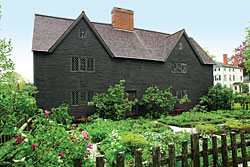 |
|
 |
|
Fig. 1: Whipple House, Ipswich
(Ipswich Historical Society)
The Whipple House was built in stages between 1677 and circa 1730. Captain John Whipple (1625-1683) built the original house with a floor plan of two rooms over two rooms (gleaned from structural evidence and an extant will). Whipple's oldest son, Major John Whipple (1657-1722), expanded the house to its present footprint, creating a structure with three over three front formal rooms, and four over four smaller rear service rooms; it is one of the largest first period homes to survive. Additionally, the interior was meant to impress, with its exposed and chamfered beams and contrasting vermillion wooden elements against whitewashed plaster, evidence of which survives. Subsequent generations of Whipples modified the home to accommodate changes in architectural taste, and in the 1950s the gables on the exterior facade were restored based on original evidence. The Ipswich Historical Society moved the Whipple House from the center of town to its present rural location in 1927.
|
Boston's North Shore was first settled by English colonists soon after the Mayflower Pilgrims disembarked at Plymouth, along what is now the southern Massachusetts coast, in 1620. The Cape Ann colony, where Gloucester and Rockport are situated on the North Shore, was settled in 1623. In 1626 the colony reorganized at Salem, then called Naumkeag. Although the first dwellings erected by the colonists in New England were often rude temporary shelters, such as English wigwams, dugouts, and tents, by mid-century a type of dwelling was introduced that architectural historians call the post-mediaeval or multi-gabled house.
The homes of this period were typically built of heavy timber frame and furnished with a large central brick chimney, a steep pitched roof with wood shingles, and split wood clapboards or weatherboards on the walls. The finer examples could have had multiple large triangular dormers at attic level, framed overhangs with pendant drops, projecting entry porch pavilions, and casement windows with small diamond panes held together with lead cames. The Whipple House in Ipswich (Fig. 1) is an opulent example of a substantial English multi-gabled house of the so-called "first period" (ca. 1630-1730).
|
 |
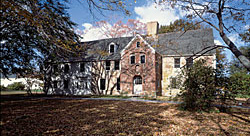 |
|
 |
|
Fig. 2: Spencer-Peirce-Little Farm, Newbury
(Historic New England)
Colonel Daniel Peirce built this unusual grand stone manor house in about 1690 (the two-story brick entry porch dates to the 1790s). The cruciform plan provides two rooms flanking a center chimney, with a service ell on the back. A National Historic Landmark, it is one of the best preserved examples of its type; the most closely related surviving structure is Bacon's Castle (1665) in Surry, Virginia. Still a functioning farm, the fields have continuously produced commercial crops since John Spencer purchased its four hundred acres in 1635.
|
A grand house of similar age, built of stone with later timber and brickwork, is the Spencer-Peirce-Little Farm in Newbury (Fig. 2). Since the 1660s another timber-frame house style began to appear on the New England landscape: the saltbox. Characterized by its steeply sloped rear roof line and central chimney, saltboxes continued in favor through the eighteenth century.1
Between about 1730 and 1780, a much more formal style of architecture, now called the Georgian or English Georgian style, became popular in New England through imported English pattern books and architectural theories originating in France and Italy. Whereas the first period and post-mediaeval buildings were generally of wood and often rambled on in asymmetrical composition, the new Georgian houses were designed with symmetrical facades, ordered by openings arranged in a grid. The finer homes were often built of brick (or wood made to look like brick and stone) and often covered with a complex two-sloped gambrel, or pyramidal hip roof. Wealthy merchants took pride in having houses built in the new style. The brick Richard Derby House on Salem's waterfront is a fine example of Georgian style architecture (Fig. 3). In nearby Marblehead, the Jeremiah Lee Mansion, built in wood but with a rusticated front to look as though constructed in masonry, is another resplendent North Shore example (Fig. 4).
|
 |
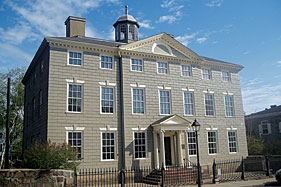 |
 |
 |
Fig. 3: Derby House, Salem (National Park Service)
The Derby House was built as a testament to the wealth and good taste of the Derby family. This brick Georgian house was built by Captain Richard Derby in 1762 as a wedding present for his son, Elias Hasket Derby, who became one of Salem's most successful merchants. At the time of construction, brick was a costly building material in New England. Richard Derby's choice of brick, large windows (glass was expensive), and a fashionable design with gambrel roof, proclaimed his family's status.
|
Fig. 4: Jeremiah Lee Mansion, Marblehead
(Marblehead Museum & Historical Society)
Colonel Jeremiah Lee, an affluent merchant, ship owner, town leader, and patriot who served in risky undercover capacities during the Revolution, built this magnificent house in 1768. Rusticated and sand-painted on all four sides to simulate stone, it was acclaimed as the Massachusetts Bay Colony�s finest home in the prosperous late colonial period. It contains a notable collection of early American furniture and decorative arts, and many of the mansion's original decorative finishes have been preserved, including rare eighteenth-century English hand-painted wallpaper, block-printed wallpaper, and a mahogany wainscot staircase. Copies of the full-length portraits of Jeremiah and Martha Lee by John Singleton Copley hang on either side of the stair landing.
|
|
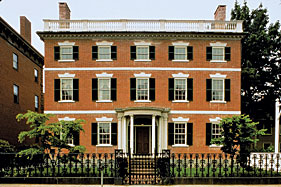 |
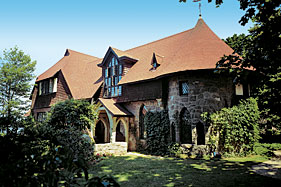 |
 |
 |
Fig. 5: Gardner-Pingree House, Salem
(Peabody Essex Museum)
The Peabody Essex Museum's Gardner-Pingree House, built for wealthy merchant John Gardner Jr. and his wife Sarah in 1804, remains the finest surviving example of the many Federal style houses built in Salem between 1793 and 1825. Its success is due to the genius of its designer, Samuel McIntire, whose innate sense of proportion and attention to decorative detail make him one of the most celebrated architects of the early Republic. The house showcases some of the most outstanding examples of McIntire's woodcarving, including the Corinthian capitals on the semicircular portico and the neoclassical ornaments on the mantels, doorframes, and furniture of the magnificent double parlor.
|
Fig. 6: Beauport, Gloucester (Historic New England)
Overlooking Gloucester Harbor, Beauport, Sleeper-McCann House, is crowned by towers, dormers, and dovecotes. Collector and interior designer Henry Davis Sleeper (1877-1934) began its construction in 1907 as a summer home and continued to enlarge it until his death. The rooms, decorated to evoke different historical and literary themes, are filled with compositions of curiosities, folk art, china, and colored glass. Beauport became well known through frequent publication, and helped shape the way we view America's past.
|
|
|
|
|
 |
 |
 |
Sights to be Seen
|
|
This year marks the 250th anniversary of the birth of Salem, Massachusetts, woodcarver and architect Samuel McIntire (see figure 5). In celebration, Salem's Peabody Essex Museum is hosting the exhibition Samuel McIntire: Carving an American Style from October 13, 2007 through February 24, 2008. The museum is a lead partner in Escapes North, a cultural tourism program created to highlight the North of Boston region's architecture, literature, and arts.
|
Highlights of the Escapes North 2007 season include:
|
|
Celebrate Salem: Four Centuries
of Architecture and Design. Includes a McIntire District walking tour through the city's historic west side. Many superb examples of the Federal style, for which architect and carver Samuel McIntire (1757-1811) was known, can be found in this area, alongside other fine examples of American architecture. Programs and walking tours continue throughout the summer.
Seventeenth Century Saturdays. Fourteen communities throughout the North Shore's Essex County open twenty-six historic buildings built between 1625 and 1725, many rarely seen by the public. Tours are on the first Saturday of each month through October.
|
Visit www.escapesnorth.com to learn more about the architecture north of Boston, including a regional architecture trail, itineraries, events, and special lodging packages.
|
After the colonies gained their independence in the Revolution, a new architectural style was desired to embody the democratic image of the young nation. American architects looked to ancient Greece and Rome, the seat of democracy, for inspiration, adopting the neoclassical aesthetics of Scottish designers Robert and James Adam. The new Federal style in America was largely evident in the decorative elements. The symmetrical Georgian facade was retained, but arches and oval rooms were introduced as well as geometric details such as round windows and classical flourishes and accents such as swags and urns. Gambrel roofs were no longer in favor, and when hip roofs were built they were often shallow in pitch and designed to be concealed beneath a crown like balustrade. Architect Samuel McIntire's Gardner-Pingree House (Fig. 5) is a superb hip roof Federal landmark, as is the Caleb Cushing House, circa 1808, in Newburyport.
The Federal style remained popular until the 1830s, but between about 1830 and 1880 more exotic and picturesque styles started to take over, including Greek Revival, Gothic Revival, Italianate, Norman, French Second Empire, Egyptian Revival, Stick Style, Shingle Style, and Queen Anne. By the time of the nation's centennial in 1876, and especially between 1880 and 1940, America's patriotic enthusiasm led to the development of styles based on early American prototypes. Though perhaps not what many people may think of as a typical pseudo-Georgian Colonial Revival structure, Beauport in Gloucester (Fig. 6), built in 1907 and continually enhanced until the 1930s, is an example of early twentieth century eclecticism and the desire to create historical perspective. The Colonial Revival swept the country and laid the groundwork for the modern appreciation of early American architecture — and the historic preservation movement.
|
|
    |
John V. Goff is the principal of Historic Preservation & Design and president of Salem Preservation, Inc. (SPI), which is working with the City of Salem to restore Salem in 1630: Pioneer Village, America's oldest living history museum.
Captions provided by the associated institutions. The editor would like to thank several architectural scholars, including James Kyprianos, for their additional expertise.
|
|
    |
1. The oldest standing integral lean-to that survives in Massachusetts is the Major Matthew Whipple house in Hamilton, built 1680-1682. (Matthew was the younger brother of John Whipple, who resided in the Whipple house [Fig. 1] in nearby Ipswich.) The house is privately owned.
|
|
    |
 Download the Complete Article in PDF Format Download the Complete Article in PDF Format    Get Adobe Acrobat Reader Get Adobe Acrobat Reader
|

|
 |
 |
|
|